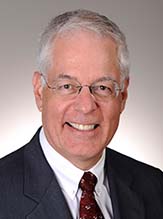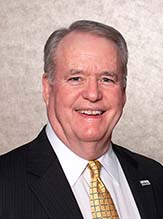
Transparency vs. visibility: Can stellar work breed invisibility to a fault?
By Rick Dana Barlow
When the ship’s captain issues the order, “steady as she goes,” and the crew delivers, few then bother the captain or even the crew.
That is until something deviates from the steadiness or simply goes wrong.
Therein lies the challenge. Depending on the ship captain’s demeanor or personality, any deviation may be seen either as a colossal mistake rating some kind of correction or discipline or it may be viewed as a chance to witness the creativity and ingenuity of the crew to return to nominal functionality.
Supply chain in healthcare is no different.
Short of a problem that elicits blame or curiosity, the C-suite typically doesn’t give Supply Chain a second glance. Consequently, the C-suite can overlook the value Supply Chain brings to the organization or enterprise.
With a sigh, healthcare supply chain executives and leaders tacitly nod in acknowledgement of the oversight.

Carl Meyer
“The value that Supply Chain delivers currently to the organization is not as sexy as M&A or building a bigger network, but it is the underpinning of the long-term success of the organization,” observed Carl Meyer, Bellwether Class of 2019, Vice President, The Wetrich Group. “Supply Chain executives need to develop the skill sets to educate the C-suite on the value that the bring, and the risk to the organization of not supporting Supply Chain to be continually developing their staff and exploring new and innovative ways of delivering new and unique value.”

George Hersch
George Hersch, Bellwether Class of 2019, intimates the clinical interoperability that Supply Chain maintains and manages throughout an organization.
“The financial impact of supply chain efforts in cost reduction and cost avoidance is often taken for granted,” he noted. “Helping C-suite executives understand the strategies in achieving this work is necessary to expand the influence of supply chain leaders. Managing physician-led value analysis committees to control the medical supply formulary and working with other organizations to reduce costs on key initiatives are two ways to illustrate the influence that supply chain has on an organization’s financial health. Additionally, the information identified by supply chain on cost per case by physician can influence contract negotiations by garnering support from key physician leaders.”
Maybe supply chain merely needs to expand its reach and extend its services, advises Jim Francis, Bellwether Class of 2017, Chair, Supply Chain Management, Mayo Clinic.
“There is no question supply chain is capable of doing more for the organization than the traditional supply chain management role – purchasing, receiving and distribution,” he noted. “Advanced supply chains are performing a myriad of services and solutions. Examples that come to mind include operating a revenue center, building out continuum of care services, retail activities, general services, third-party risk management, business continuity, etc. Ability to manage more than traditional activities is highly contingent on skill and abilities of the supply chain executive and his/her team.”

Jean Sargent
Attitudes about supply chain can reflect the business acumen of an organization, according to Siobhan O’Bara, Senior Vice President, Industry Engagement & Services, GS1 US Healthcare, Silver Sustaining Sponsor.
“A savvy organization does not overlook or undervalue their supply chain,” she said. “Growth opportunities in the healthcare industry today come from improving operating outcomes or management of expenses. Those improvements don’t happen if you’re not paying attention to your supply chain. Back in the late 1990s and early 2000s industry growth was organic; then in the 2000-teens it was coming from mergers and acquisitions. But today’s growth opportunities are coming from well-run operations, and the supply chain is a major driver of reduced costs, improved facility management as well as increased patient safety and outcomes.”
Still, there may be ways to navigate around that vision from a business perspective.
“Many supply chain leaders are underappreciated because it is hard to capture actual savings that occur when you negotiate contracts,” said Rand Ballard, Chief Customer Officer, Vizient Inc., Founding Sustaining Sponsor. “The way to reverse that is to partner cross-functionally from a service line perspective and affect total cost of the service line, not just on individual products.”

Tom Lubotsky
Tom Lubotsky, Senior Vice President, Supply Chain, Allina Health, Bronze Sustaining Sponsor, points to another essential area growing in importance.
“Formulary management may be one of the unnoticed sets of work that C-suite executives may not be fully aware that is managed carefully by supply chain,” he said. “There are multiple daily requests that come into the Supply Chain department. Many times these products are evaluated to determine if there are suitable alternative products already approved. Often, the engagement of physician subspecialty leaders assist with these reviews, sometimes on an emergent basis for one-time exceptions that need to be upheld under unique patient care conditions. Loosely organized new product introductions and evaluations can be very costly to a supply chain threatening new spend that had not been planned in an operating year or creating expired product situations should new products become the preferred choices on a recurring basis.”
Developing a scorecard can help.
“Maintaining a scorecard on new product requests and introductions should bring to light the cost avoidance of products already approved on formulary that are recommended to use,” Lubotsky recommended. “In addition, it is imperative to also show the number of exceptions granted that led to better patient experiences and outcomes of care so that both C-suite and physicians have a balanced sense of advancing care with the adoption of new products versus only relying on current formulary choices. Inventory valuations at year end can also indicate how well supply chain is managing the new, current and expired products as new introductions are requested.”

Dee Donatelli
Overlooking supply chain contributions in healthcare happens all too frequently, according to Dee Donatelli, Bellwether Class of 2015, Vice President, Professional Services, symplr.
“Basic excellence in customer service and logistics management is oftentimes unnoticed – that is until it fails,” Donatelli lamented. “Creating an environment that recognizes and more importantly openly appreciates day to day success is a critical part of C-suite.”

Shaun Clinton
Shaun Clinton, Senior Vice President, Supply Chain, Texas Health Resources, Bronze Sustaining Sponsor, credits his organization’s C-suite for their foresight.
“I am fortunate that, by and large, my C-suite recognizes what we do, and in some cases, why we do it the way we do,” he said. “I do think they are starting to realize that the amount of data I can bring to the party can really help them make informed decisions.”

John Gaida
John Gaida, Bellwether Class of 2018, harrumphs at the hoopla surrounding Supply Chain’s quest for the C-suite.
“I continue to be perplexed (as I have been) with the endless desire of some to be part of the C-suite or to obsess with the C-suite's opinion of SCM,” he noted with a tinge of dismissiveness. “I think it is a waste of time and seems to be an endless fascination that the supply chain profession can do without. Do the best you can with the tools you have and strive to innovate for the betterment of the organization, and you'll be fine!”